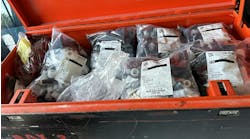Latest from Plumbing
Sponsored
WASHINGTON – The U.S. Environmental Protection Agency was preparing to solicit live input in early February on the agency’s draft of a performance specification for high-efficiency urinals under its WaterSense program.
The EPA is nearing the publication of a final specification and will accept written comments up until March 9. Meanwhile, plumbing contractors, manufacturers, retailers and distributors could provide comment on the draft of the HEU specification on Feb. 5 during a telephone conference hosted by the EPA.
Stephanie Tanner, environmental engineer for the EPA’s WaterSense program, said the EPA is looking for feedback from contractors regarding any concerns they may have about the performance or operation of products labeled under the WaterSense program.
“We’d like to hear what people think about how the products will work in the building system,” she said. “It’s one of our bigger concerns to make sure that the products that we label actually work well in the building system and don’t cause some sort of unintended consequence. If contractors have concerns that products will have some unintended consequence in the building system, we would definitely want to know that, and if they had independent evidence of that, we would be very interested in seeing it.”
The EPA originally notified the industry that it intended to develop a WaterSense specification for HEUs in May 2008.
The draft specification applies to urinal fixtures that receive liquid waste and use water to convey the waste through a trap seal into a gravity drainage system and pressurized flushing devices that deliver water to urinal fixtures.
In its current form, the EPA’s specification lays out a number of criteria for HEUs. According to the EPA’s draft specification, the average water consumption of urinal fixtures and pressurized flushing devices must not exceed 0.5-gal. per flush.
In addition, the average water consumption must not exceed 0.5-gpf when tested in accordance with ASME A112.19.2 or IAPMO Z124.9.1 as applicable.
When it comes to pressurized flushing devices, the draft specification dictates that such devices must not exceed the rated flush volume of water even if the actuator is in the flush position, meaning that the device must have a non-hold-open actuator. Pressurized flushing devices must conform to ASSE 1037.
The packaging, markings or instructions provided with pressurized flushing devices also must not direct the user to an alternative flush volume setting that would override the rated flush volume of 0.5-gpf, according to the EPA’s draft specification.
Tanner also noted that, “contractors should be aware that for fixtures that are a pint (per flush), those fixtures have to be matched with the right valve. You cannot put a 1-pint flush valve on a currently existing fixture.”
Also significant in the specification is a requirement that pressurized flushing devices must not contain interchangeable parts, such as pistons or diaphragms, which when replaced with commonly available alternative components would allow the device to flush at a higher volume, according to the EPA.
Tanner said this is a key point for contractors to be aware of because people who manage the supply for a building are not always the same people who install and maintain the building’s fixtures.
“You can actually eliminate the efficiency of a fixture by putting in different replacement parts,” she said. “In commercial products, there’s a lot more variability in how products are mixed and matched. You can buy a WaterSense labeled flush valve, and as long as you buy another WaterSense labeled fixture, then you’re going to have a functioning urinal.”
In addition, the specification outlines requirements for urinal fixtures. Vitreous china urinal fixtures must conform to ASME A112.19.2 requirements and plastic urinal fixtures must conform to IAPMO Z124.9 requirements when tested with a pressurized flushing device as accepted by the EPA.
Shawn Martin, technical director of the Plumbing Manufacturers Institute, applauded the EPA for its efforts to garner industry input on its WaterSense program.
“(The EPA) certainly has gone through a very rigorous period of discussions with the industry, and that’s certainly always very welcome from our standpoint,” he said. “We think that the water consumption level of 0.5-gpf seems very appropriate and a prudent step to take.”
However, missing from the draft specification is a standard for waterless urinals, composting urinals and retrofit devices or other aftermarket retrofit systems.
Martin said many manufacturers still are trying to assess their positions on the lack of a waterless urinal component in the specification.
“(The EPA) is sort of between a rock and a hard place on this one because the point of the (WaterSense) program is to save water, and when you’re talking about a waterless urinal, you really can’t save any more water than zero,” he said.
Tanner said the EPA attempts to base its product categories on existing standards, adding that the existing standard for urinals is different from the existing standard for waterless ones.
“As a federal program, we also try to avoid spending resources to encourage people to buy things that are already efficient,” she said.

